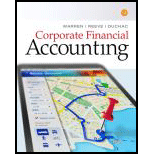
Corporate Financial Accounting
14th Edition
ISBN: 9781305653535
Author: Carl Warren, James M. Reeve, Jonathan Duchac
Publisher: Cengage Learning
expand_more
expand_more
format_list_bulleted
Concept explainers
Textbook Question
Chapter 8, Problem 8.4BE
Analysis of receivables method
At the end of the current year,
Determine (A) the amount of the
Expert Solution & Answer
Trending nowThis is a popular solution!

Students have asked these similar questions
Hello tutor please provide correct answer general accounting
What was George company's adjusted COGS amount for 20x1
None
Chapter 8 Solutions
Corporate Financial Accounting
Ch. 8 - What are the three classifications of receivables?Ch. 8 - Dans Hardware is a small hardware store in the...Ch. 8 - What kind of an account (asset, liability, etc.)...Ch. 8 - After the accounts are adjusted and closed at the...Ch. 8 - A firm has consistently adjusted its allowance...Ch. 8 - Which of the two methods of estimating...Ch. 8 - Neptune Company issued a note receivable to...Ch. 8 - Prob. 8DQCh. 8 - The maker of a 240,000, 6%, 90-day note receivable...Ch. 8 - Prob. 10DQ
Ch. 8 - Direct write-off method Journalize the following...Ch. 8 - Allowance method Journalize the following...Ch. 8 - Percent of sales method At the end of the current...Ch. 8 - Analysis of receivables method At the end of the...Ch. 8 - Note receivable Prefix Supply Company received a...Ch. 8 - Prob. 8.1EXCh. 8 - Prob. 8.2EXCh. 8 - Entries for uncollectible accounts, using direct...Ch. 8 - Entries for uncollectible receivables, using...Ch. 8 - Entries to write off accounts receivable Creative...Ch. 8 - Providing for doubtful accounts At the end of the...Ch. 8 - Prob. 8.7EXCh. 8 - Aging of receivables schedule The accounts...Ch. 8 - Estimating allowance for doubtful accounts Evers...Ch. 8 - Adjustment for uncollectible accounts Using data...Ch. 8 - Estimating doubtful accounts Outlaw Bike Co. is a...Ch. 8 - Entry for uncollectible accounts Using the data in...Ch. 8 - Entries for bad debt expense under the direct...Ch. 8 - Entries for bad debt expense under the direct...Ch. 8 - Effect of doubtful accounts on net income During...Ch. 8 - Effect of doubtful accounts on net income Using...Ch. 8 - Entries for bad debt expense under the direct...Ch. 8 - Entries for bad debt expense under the direct...Ch. 8 - Determine due date and interest on notes Determine...Ch. 8 - Entries for notes receivable Valley Designs Issued...Ch. 8 - Entries for notes receivable The series of five...Ch. 8 - Entries for notes receivable, including year-end...Ch. 8 - Entries for receipt and dishonor of note...Ch. 8 - Entries for receipt and dishonor of notes...Ch. 8 - Receivables on the balance sheet List any errors...Ch. 8 - Allowance method entries The following...Ch. 8 - Aging of receivables; estimating allowance for...Ch. 8 - Compare two methods of accounting for...Ch. 8 - Details of notes receivable and related entries...Ch. 8 - Notes receivable entries The following data relate...Ch. 8 - Sales and notes receivable transactions The...Ch. 8 - Allowance method entries The following...Ch. 8 - Aging of receivables; estimating allowance for...Ch. 8 - Compare two methods of accounting for...Ch. 8 - Details of notes receivable and related entries...Ch. 8 - Prob. 8.5BPRCh. 8 - Sales and notes receivable transactions The...Ch. 8 - Continuing Company AnalysisAmazon: Accounts...Ch. 8 - Ralph Lauren: Accounts receivable turnover and...Ch. 8 - Prob. 8.3ADMCh. 8 - Prob. 8.4ADMCh. 8 - Ethics In Action Bud Lighting Co. is a retailer of...Ch. 8 - Communication On January 1, Xtreme Co. began...
Knowledge Booster
Learn more about
Need a deep-dive on the concept behind this application? Look no further. Learn more about this topic, accounting and related others by exploring similar questions and additional content below.Similar questions
arrow_back_ios
SEE MORE QUESTIONS
arrow_forward_ios
Recommended textbooks for you
 Intermediate Accounting: Reporting And AnalysisAccountingISBN:9781337788281Author:James M. Wahlen, Jefferson P. Jones, Donald PagachPublisher:Cengage LearningPrinciples of Accounting Volume 1AccountingISBN:9781947172685Author:OpenStaxPublisher:OpenStax College
Intermediate Accounting: Reporting And AnalysisAccountingISBN:9781337788281Author:James M. Wahlen, Jefferson P. Jones, Donald PagachPublisher:Cengage LearningPrinciples of Accounting Volume 1AccountingISBN:9781947172685Author:OpenStaxPublisher:OpenStax College- Century 21 Accounting Multicolumn JournalAccountingISBN:9781337679503Author:GilbertsonPublisher:Cengage
 College Accounting, Chapters 1-27AccountingISBN:9781337794756Author:HEINTZ, James A.Publisher:Cengage Learning,
College Accounting, Chapters 1-27AccountingISBN:9781337794756Author:HEINTZ, James A.Publisher:Cengage Learning,

Intermediate Accounting: Reporting And Analysis
Accounting
ISBN:9781337788281
Author:James M. Wahlen, Jefferson P. Jones, Donald Pagach
Publisher:Cengage Learning


Principles of Accounting Volume 1
Accounting
ISBN:9781947172685
Author:OpenStax
Publisher:OpenStax College


Century 21 Accounting Multicolumn Journal
Accounting
ISBN:9781337679503
Author:Gilbertson
Publisher:Cengage

College Accounting, Chapters 1-27
Accounting
ISBN:9781337794756
Author:HEINTZ, James A.
Publisher:Cengage Learning,
Accounts Receivable and Accounts Payable; Author: The Finance Storyteller;https://www.youtube.com/watch?v=x_aUWbQa878;License: Standard Youtube License